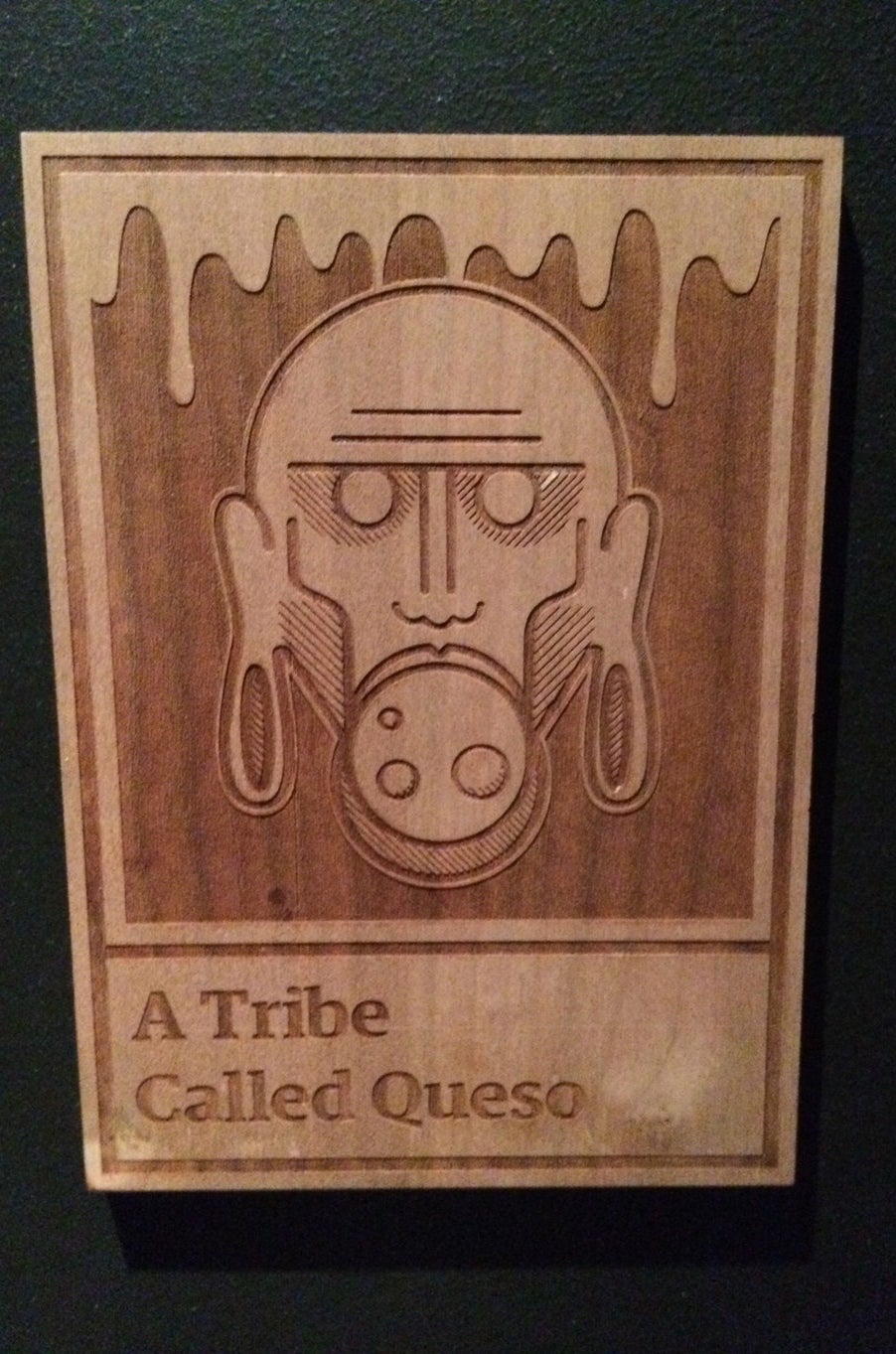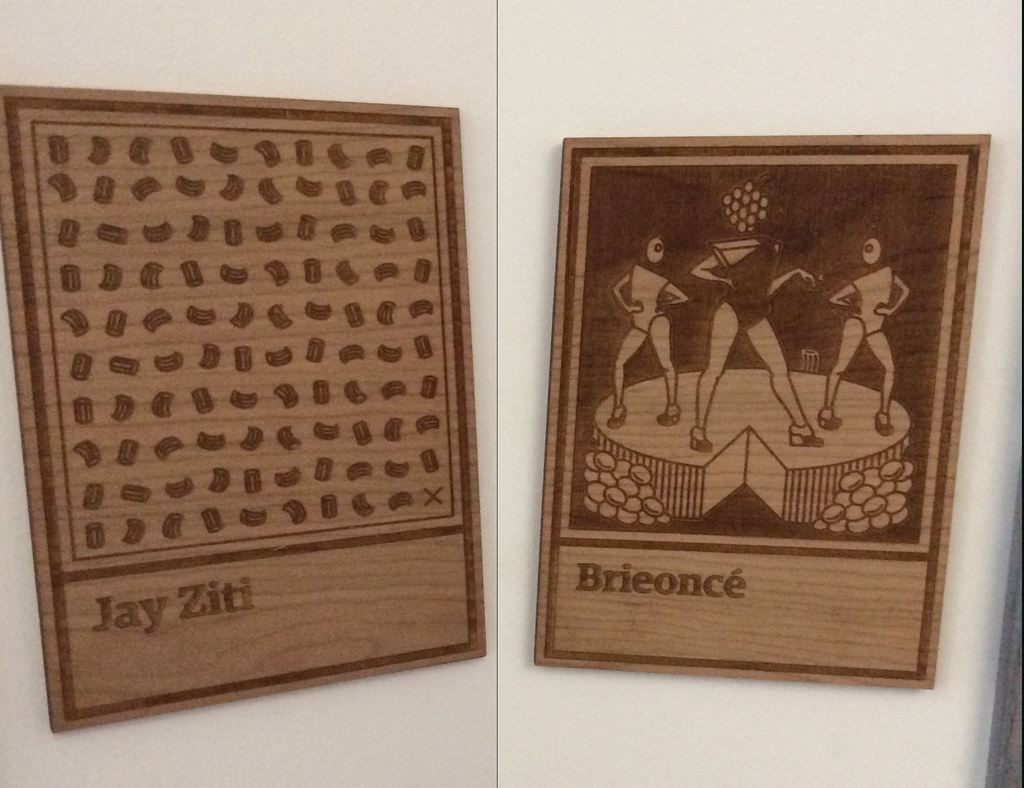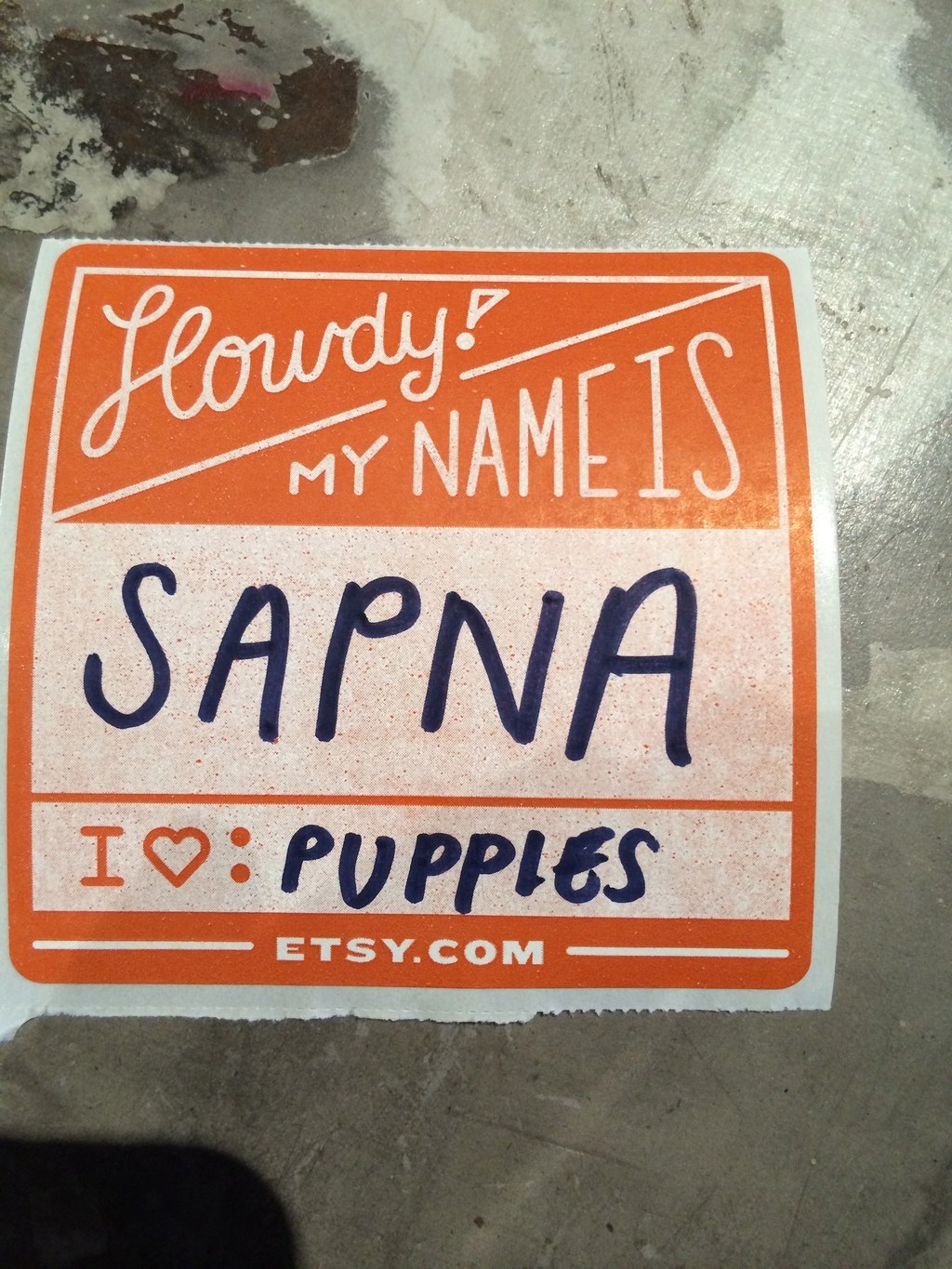
Etsy has built a massive business in the trafficking of whimsy — growing into a $1 billion-plus business since 2005. The online marketplace is now home to a million sellers peddling a staggering array of items, from superhero capes for small children to Carolina Pine office tables to oversized Scrabble tiles for decorating your place with words like "HOME" (nine points).
The company's headquarters in the Dumbo section of Brooklyn — at least until they move to a bigger spot nearby — is as charming as the website's locally made merchandise. Dark green foliage lines the entryway, making the path to reception feel somewhat magical. The name tags include two spaces: one for your name, and another for something you love. Corgis roam free. And the conference rooms are labeled with food puns on musician names: A Tribe Called Queso, Modest Mousse, Jay Ziti, and Brieoncé, to name a few.
Etsy CEO Chad Dickerson has overseen radical changes in the company since he took the job in mid-2011. The company generated $1.35 billion in transactions last year, up from $895 million the prior year. Its website now has 40 million members, from just shy of 10 million three years ago. It has raised $91 million in funding from investors including Accel Partners, Index Ventures, and Union Square Ventures.
Most importantly, Dickerson, 42, has been charged with maintaining Etsy's integrity as a marketplace for handmade goods while working to grow the company and keep its most successful sellers on the site. Etsy's decision to allow vendors to use outside manufacturers last fall was met with some confusion and anger in the DIY community, as was the introduction of Etsy Wholesale, which will be out of beta in August. Dickerson, who started his career at the Raleigh News & Observer and other media outlets before heading to Yahoo, discussed those changes and how they were represented in the media and shared his thoughts on e-commerce, New York City's tech scene, and the show Silicon Valley.



There have been some not-so-flattering stories about the addition of factory-made production. What are your thoughts on those?
Chad Dickerson: People who really looked deep into it and have done the homework see the vision that we have for it. The kind of sensational view is, "Oh my god, Etsy has opened up to factories, this is not what Etsy is supposed to be," but I think journalism is really about looking a level deeper. And when you look a level deeper, the story we were telling was there are many different ways people make things, and since the beginning of Etsy, we had something called partial production, where you could use outside production to partially produce something. That's a very confusing concept if only because the way things are made in the world is very complicated. So most of the knitters on Etsy don't make their own yarn, most of the woodworkers don't mill their own wood — we really respect the ones that do — but having something be 100% handmade in the strictest definition of the word is really complicated.
Since the beginning of Etsy, you come to Etsy, you want to build a business, you want it to be successful, and then you get featured on Martha Stewart or you get featured on a blog and you get this — we heard this experience over and over again — the seller gets kind of a crushing amount of orders. ... We had a wedding seller that said she started to dread wedding season because she was just really reaching her capacity. So the policies were really based on not supporting giant mega-businesses, but helping the types of people who come to Etsy, and become successful on Etsy, continue on the path of success. And wholesale's the same way.
How so?
CD: Wholesale is something that's been happening on Etsy since the beginning. ... Our seller education team wrote their first blog post about how to be successful in wholesale, I believe, in 2006, 2007. ... We really wanted to support that but also create a common context around that, so that's when we updated our policies. They really centered around authorship, responsibility, transparency.
So in a non-nuanced way, it's like Etsy is allowing factories, but the deeper story is you still have authorship, you still have to create what you're selling, responsibility, you have to understand how it's made from end to end, you can't just sort of send it off and not know how it's made, and the transparency is you have to actually say on your about page for sellers that "I'm using outside help, I'm using a manufacturer."
So we really saw it as a step forward in a big way, and we're starting to see the vision there, we're starting to see this vision of more community-based small-scale manufacturing really take hold — and 80% of sellers on Etsy, if you look at the U.S., who are using outside production, are using outside production in their own state.
How does it actually work?
CD: [Gesturing to his messenger bag] The person who made this bag, Tielor McBride, his shop is named TM1985, he's based in Brooklyn. He was actually the first person we approved for outside manufacturing. He works with a small family-owned shop in New Jersey to make these.
He obviously designed the bag and conceived the bag, but when he works with this outside firm over in New Jersey, he goes over there, works with them, they talk about how it's made, they look at the zippers. ... It's very far from the idea of sending it off somewhere where you totally lose touch. If you look at his shop page, he says, "I work with a manufacturer in New Jersey."
Another one, and this really reinforces the idea of remaking the economy, is a woman, Allison Faunce, from Little Hero Capes. She makes superhero capes for kids that are really, really cute. ... She started hitting the limits of her production so she went to a local factory in Fall River, Mass. It was a factory run by a gentleman who had a really thriving business in the '80s, and gradually, his business really deflated as more and more work went offshore. So she went and talked to him and they've been working together to increase production on these capes. ... He was surprised to have someone like Allison come to him and say, I'm making these capes, so he started hiring people again.
That was kind of the world we were envisioning. This is where I'm dissatisfied with some of the coverage — there was no smoky-room plotting of me pounding my fists on the table saying, "We must increase production!" It wasn't like that at all. It was like, "Hey, it doesn't make sense to us that these good people who started on Etsy are kind of hitting a wall on Etsy and we're not allowing them to work with people in their own communities to continue it." So the way we're seeing it play out is it really plays into the whole idea that's fundamental to Etsy about these human relationships. It's just that the human relationship is between Allison and the factory owner, between Tielor and the manufacturer.
Are there incentives then to work with people in the U.S.?
CD: We don't have particular incentives to work with someone in a particular place, but we do use the word "faceless," and I think that's really important, the responsibility and transparency piece of the authorship.
First of all, you have to apply to work with a manufacturer, and in that application, you have to demonstrate that you understand the process. If you say, "I work with a factory, and I don't know anything about the factory at all, I don't even know who owns the factory," then that doesn't pass the responsibility test and the transparency test. It's all about disclosing. If you pass the responsibility test, you have to disclose that you're working with someone and you have to disclose the location.
Can you sort by "Made in America"?
CD: You can't. We're a global platform. If you're a buyer, you can look or you can make that decision yourself.
You can search by sellers based in London or anywhere, but we think it's really important that Etsy's a global marketplace, and also this idea that you can start a business on Etsy doing something that you love to do, very creative work. ... We want that to be universal. Whether you're in the U.S, or the U.K., or Australia, China, India, we want anyone to be able to participate.
Have you hired more people to police outside manufacturing as you've opened up the platform?
CD: We don't really break it out publicly, but in all areas of the company, we've grown staffing as the needs have grown. So we've hired more engineers to work on the platform, we've hired more people on our Marketplace Integrity and Trust & Safety Team to work on that, so that group continues to grow and grow and grow. And we've hired people on those teams who focus purely on the manufacturing applications and that sort of thing.
That's one area where there has been, I think, some unfair journalism. We've always acknowledged that we have our own version of spam in the marketplace because it is open, but it's always a fraction of 1%, so we're always sweeping it away. People don't come to Etsy for that kind of stuff. It's something we don't want in the marketplace, it's not something that's good for our business, either.
I visualize a lot of knitting going on in an Etsy tribunal.
CD: The outfits would be all unique, without a doubt.
Is Pinterest a big driver of traffic for you?
CD: Pinterest is one of our top sources of traffic. ... But part of the reason that Pinterest drives traffic to Etsy is because Pinterest users love Etsy so much that they're pinning things from Etsy all the time. ... I think it's in many ways a symbiotic relationship.
There was a study a year or so ago [that showed] Etsy was the most pinned domain other than Google Images — which, arguably, Google Images doesn't count because they're aggregating everyone else's images. So Pinterest and Etsy are tightly linked in that way. I think the customers of both enjoy both of those.
Are there ways you can leverage that relationship with them and do more?
CD: I think so. I mean, I talk to Ben [Silbermann] occasionally and so we're always having conversations about that kind of thing but nothing specific. ... One of their engineers over there used to work for me at Yahoo, so there's lots of connections. We're very friendly.
In a lot of the articles about Etsy in the past year, there's always talk of an IPO. Is that the only way for the people who have funded you so far to cash out? What about a sale?
CD: I'm going to talk academically, but I want to make sure this isn't me suggesting what Etsy will do. An IPO's obviously one way, as you noted. ... Another way is you can sell, as you pointed out. I think the way we look at Etsy, selling the company to another company isn't something we're looking to do at all because I think the community is so special, and what Etsy is is so unique and special. It's really important that Etsy remain a stand-alone company, so that's kind of how we feel about that.
The academic part is — so you have an IPO and a sale. You can also continue to raise money. I think we're in a really interesting time because people are raising money, like the Uber round and some of the Pinterest rounds and Dropbox. The amount of money that people are willing to invest in the venture world is way beyond what we've seen before.
There's so much money kind of floating around, it's hard to know what the future will look like, but theoretically, you could raise another round of funding and those people could buy out your existing investors. To me, I like our investors.
Union Square Ventures, Accel are invested in Etsy right now — if some other investor came in and bought their stakes, that would be really distracting, and so that's not something that we're really interested in either.
Some companies are raising money because they need the operational capital, but in that way, we're a little unusual because we're profitable. ... Profit means you're running the business responsibly, you're making money to reinvest and that sort of thing. It's a little unusual in this day and age.
What do you think of the New York tech scene right now, given what happened with Tumblr, FourSquare's transition, and Fab, of course. What does it look like from when you started as CEO? Is it less hot?
CD: It's different. September will be six years here. When I came in 2008, I think Tumblr was just getting going and FourSquare was just getting going, there was no Facebook office, no Amazon or Twitter. I can't think of a lot of the West Coast companies, other than Google, who was already out here — there was a tiny Yahoo office. A lot has happened in six years. Tumblr had their exit, which I think was really good for Tumblr and good for New York.
How was it good for New York?
CD: It was a $1 billion deal, and this isn't necessarily how I score things, but I think people look at how much value you're creating. They look at sort of how much your company is worth, and there's a lot of talk when you read in the media about the "billion-dollar club." A $1 billion valuation doesn't actually mean anything — it's almost like saying, "My house is worth whatever," but until you sell it, you don't actually know what it's worth. Tumblr had a legitimate $1 billion exit.
There are some really interesting companies out there that maybe aren't getting as much press as some of the companies that had been getting press, so, like, 10gen is one example with MongoDB. ... That's a software infrastructure company based in New York. If you didn't know it was in New York, it sounds like a Silicon Valley company. So I think that the scene is just different.
The way I would measure the intensity of the scene, I wouldn't measure it in headlines, I would measure it in competition for engineers, which is as hot as ever.
And how is the competition for engineers?
CD: As hot as ever. There are a lot of comparisons obviously between New York and Silicon Valley — there used to be a lot of comparisons between New York and Boston and I don't really hear those anymore.
It's not that the New York scene is degrading in any way. Because I came in 2008, I'm a little influenced by that, but I felt things really started taking off locally around that time, and I feel like these things take a long time.
Silicon Valley didn't produce Facebook in 1968. It took Fairchild Semiconductor and Intel and that kind of ecosystem to develop, and Stanford and Berkeley to build engineering programs, and now it's tech everywhere. In New York, it's almost like we're building the Fairchild Semiconductors and the Intels and that kind of stuff and the universities, the Cornell-Technion program on Roosevelt Island, right now.
To me, it's almost like tracking the stock market. You could look at various things and say, maybe New York's stock price isn't as high as people want it to be right at this moment, but just like you invest in companies for the long-term, you invest in regions for the long-term. I think New York is putting everything in place to continue to be a key player. To say that we're "trying" to be a key player, I think would be underrating New York. Again, looking at the New York–Boston comparison — I don't hear anyone talking about that anymore. Sorry to the Boston people, there's a lot of good stuff happening there. But people compare New York and Silicon Valley.


Why do you like being in New York?
CD: New York is a great place to build tech companies because it's so international, it's so diverse. Not just racially, ethnically, but the jobs that people have.
My social experience in New York is so much different than it was when I lived in California, where if I went to a party, everyone was a product manager, an engineer, or a designer. Now I go to a party and there are actors, writers. I think building a tech company now that the internet and everything is mobile and everything is more mainstream in a place like this is a really good long-term bet.
Do you watch the show Silicon Valley?
CD: I absolutely love it. It is terrifyingly good. I think it's really right on. My wife is not really into tech and everything, so I think she doesn't know why I'm laughing so hard and thank goodness for that. But I mean, such attention to detail. They recreated TechCrunch Disrupt, and had Kara Swisher in there and had Mike Arrington in there and the sort of weird computer science guys with the Vibram shoes, and the founder guy, Bachman — there are so many people like that. They really nailed it.
Hopefully that doesn't exist so much in New York.
CD: I was talking to a friend of mine, a late-night conversation sitting on the roof one night, and we were talking about how we were so glad to be in New York because you know, the way I think about it is that Silicon Valley has almost this Hollywood sort of thing going on, where the local CEOs and entrepreneurs are the stars.
I mean I live in Brooklyn. Jay Z is from Brooklyn. How cool can you be if you live where Jay Z is? Spike Lee works in our building. ... The point being, New York is so diverse, and everyone here is really excited about tech and what we're doing, but also in a weird way, it's kind of grounding because you're just one of many industries here. I think that's actually a strength, not a weakness, because if there is anything you could really say the show Silicon Valley is about, it's about hubris and it's hard. It's hard to sort of have hubris when you're working in an environment of people who are so successful in so many different ways — like some of the top musicians, ballet, you're just one of many. I think it's more diverse and it keeps you grounded.
I'm curious about your thoughts on the e-commerce landscape now, looking at some once-hot companies like Fab and Gilt.
CD: Etsy is very different from those traditional e-commerce outfits since we're a network of a million sellers around the world. ... We don't have a really large merchandising team that's deciding what to order and trying to predict what the trends are, because in many ways the marketplace kind of self-regulates with supply and demand.
Fundamentally, when I look at the larger e-commerce landscape, outside of fashion and the ones you mentioned, at some point, you're competing with Amazon. In a world where you're holding inventory, you're trying to meet customer expectations of fast shipping, discounting and low prices, and all that kind of stuff, I think that it gets really, really tough because Amazon has kind of created an expectation with things like Prime and really fast shipping that you're going to get things really quickly.
So I see a lot of these companies trying to out-Amazon Amazon, and I think that's a tough road for those kinds of companies with the thin margins and logistics challenges and all that kind of stuff. I wouldn't want to be in that business. ... We're competing in a different way than price and convenience.

So your volume of sales, that's not so far from something like Lululemon, but obviously the money you're making is nothing like what they're making on expensive yoga pants.
CD: We have multiple revenue streams. One mistake people make is they see the 3.5% take when something sells and they say, oh, Etsy's revenue is $1.35 billion times 3.5%. But that's only one part of it.
There's the listing fees ... of 20 cents per item listed, we have a payments processing platform as well, so when you use our payments platform, there's a small fee associated with that. We provide shipping services, so if you're a U.S. seller and you're selling to someone in the U.S., you can print a U.S. postal service shipping label.
We also provide promotional services, sort of search ads, which is basically [like Google] AdWords for Etsy.com. You can buy paid placement in search and that's a really good revenue stream for us, as well. The wholesale program is really nascent, we're not charging fees right now, but we announced pricing, and will be starting to charge fees starting in August. So that number we can release: We have zero revenue on that right now.
Going into 2011, we only had two revenue streams, really, which were listing fees and the 3.5%. So all the ones that are not those, we've had since mid-2011.
Do you guys take bitcoin?
CD: We do not.
Are you going to?
CD: We don't have any plans to do bitcoin. But the interesting thing is that there are some bitcoin sales because buyer and sellers can still negotiate between themselves. A very small percentage of people do this, but you can pay by check and money order and all that kind of stuff, so there are a small number of instances where buyers and sellers agree to transact via bitcoin. But it's not going through Etsy.
But bitcoin is very fascinating.
Do you think it's the way of the future?
CD: I'm still learning. I actually own bitcoin.
How much?
CD: One. Just out of curiosity. I was not a speculator, I just wanted to go through the process of buying.
I bought it I think at the absolute peak price of around $700. I haven't looked at it recently — it might be $600, $500. I bought it before the whole Mt. Gox thing happened. I want to spend it to see what the spending experience is like but I just keep not doing it.
Etsy's first TV commercial just aired in the U.K.
View this video on YouTube


